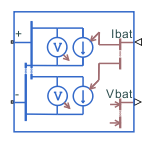Passive Balancing Interface
Interface for cell balancing between battery and cell supervisory circuit
Since R2024a
Libraries:
Simscape /
Battery /
HIL
Description
The Passive Balancing Interface block provides an abstracted vectorized interface for cell balancing between a battery and a cell supervisory circuit. Use this block with desktop simulations and hardware-in-the-loop battery emulation hardware.
A cell supervisory circuit is an electronic circuit that connects to battery cells or parallel assemblies. You can use this circuit to normalize voltages or states-of-charge (SOC) inside a module or pack. In the real world, you implement this equipment between your battery and the battery management system (BMS) control.
This figure represents the real-world equipment, voltages, and currents.

To avoid damaging your battery and to test your cell balancing algorithms under standard operational conditions and fault conditions, you can use hardware-in-the-loop battery emulation hardware. You can use an abstracted interface to connect, set, and configure the passive balancing BMS to your emulated battery.
In this figure:
The blue color represents the real-world equipment, voltages, and currents.
The green color represents the interface between the real-world and simulated equipment, voltages, and currents.
The orange color represents the simulated equipment, voltages, and currents.

The Passive Balancing Interface block provides the abstract representation of power electronic equipment without the need to model it in detail. For example, if you have a battery pack with different levels of temperature or voltage in its constituent parts, you can use this block to check if the BMS is correctly balancing your pack after operational scenarios.
Ports
Input
Output
Conserving
Parameters
Extended Capabilities
Version History
Introduced in R2024a
See Also
ParallelAssembly | Module | ModuleAssembly | Pack | Array of Electrical Nodes
Connector
